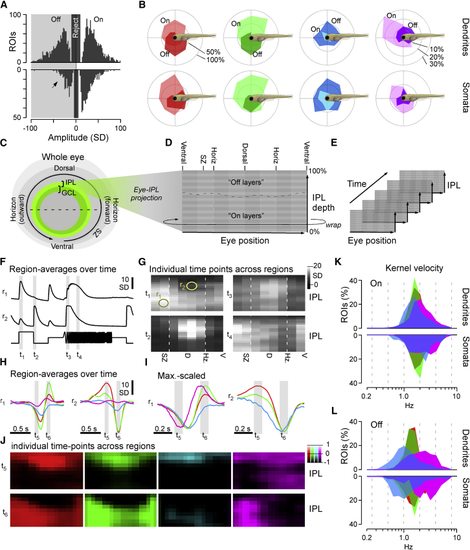Figure 2
- ID
- ZDB-FIG-200817-36
- Publication
- Zhou et al., 2020 - Zebrafish Retinal Ganglion Cells Asymmetrically Encode Spectral and Temporal Information across Visual Space
- Other Figures
- All Figure Page
- Back to All Figure Page
|
Major Functional Response Trends across the Eye (A) Kernel amplitudes of all dendritic (top) and somatic (bottom; y-flipped) ROIs, shown for the maximal amplitude kernel of each ROI irrespective of color. For a breakdown by color, see (B) Prominence of different color and polarity responses among dendrites (top row) and somata (bottom row), plotted across visual space. In each case, all kernels that exceeded a minimum amplitude of 10 SDs were included. Scale bars in percent of dendritic/somatic ROIs that were recorded in a given section of the eye such that the percentages of On, Off, and non-responding (<10 SD) add to 100% are shown. (C–E) Schematic illustrating how dendritic ROIs from different parts of the eye and IPL depth (C) were mapped into a 2D “Eye-IPL” map (D), which can then also be analyzed over time (E). Note that this involved “cutting” the circular range of eye positions such that the ventral retina is represented at either edge along the 2-projections’ x axis. (F and G) Example snapshots of mean responses to chirp stimulation (cf. (H–J) As (F) and (G) but instead showing mean kernels across the four spectral wavebands, where (H) and (I) are mean and max-scaled mean kernels for Eye-IPL regions r1,2 (as in F), respectively. (J) shows each kernel’s full Eye-IPL map at two time points t5,6 as indicated in (H) and (I) (see also (K and L) Distribution of central frequencies ( |

